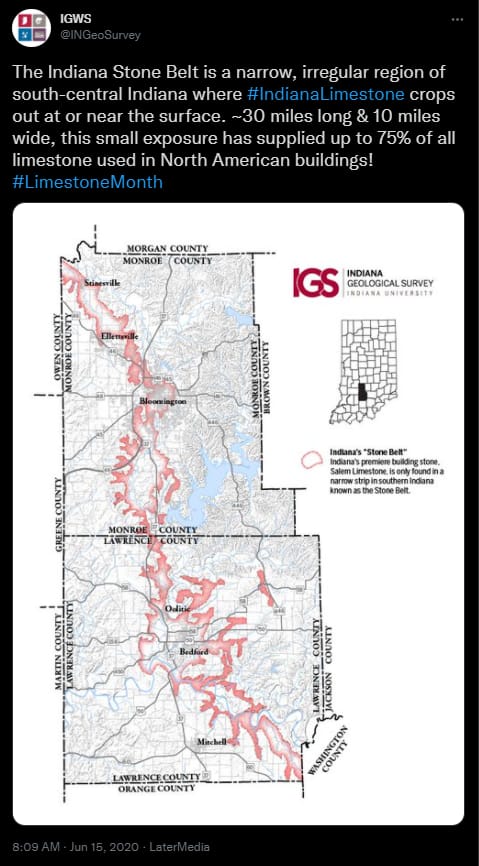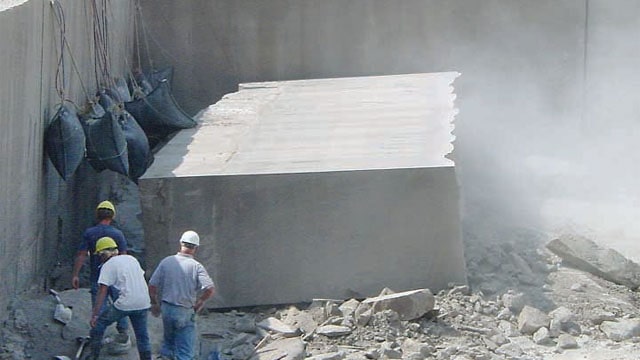Indiana Limestone Ontario Distributor
When it comes to constructing beautiful buildings and structures that can last for a lifetime or two, few materials come to mind other than Indiana limestone. The natural rock has a remarkable history and is one of the most-used stones in North American architecture such as educational institutions (Indiana University), government buildings and iconic buildings such as the Royal York Hotel.
Indiana limestone’s durability, ageless beauty, and versatility make it a sought-after natural stone for builders and masons worldwide. However, many property owners are unaware of the centuries-old history and surprising benefits of the stone. Consider the valuable guide below to learn all you need to know about Indiana limestone, its advantages, and its applications.
For years, Outside Stone has been the go-to wholesale supplier of high-quality Indiana limestone products. Discover more about this fascinating building material by reading below and checking out the Outside Stone product catalogue.
Table of Contents
- What Is Indiana Limestone?
- Indiana Limestone Characteristics
- Indiana Limestone Rock Color, Texture, and Grading
- Benefits of Indiana Stone
- Using Indiana Limestone for Residential Properties
- FAQ
- Closing
What is Indiana Limestone
Indian limestone has several names, including Bedford limestone and Salem Formation, its geological formation name. It’s a natural grainstone with a uniform grade and texture, and it comes from quarries within Indiana’s Monroe and Lawrence Counties.
The creation of Indiana limestone took over 300 million years. Back in the Mississippian Age, a shallow sea covered a substantial portion of the Midwest United States. During that time, the waters teemed with invertebrates like coral, echinoderms, and Mollusca that absorbed calcium carbonate from the water to create shells and skeletons.
As the creatures died, their hard body parts decomposed into white sands that settled on the ocean floor. When combined with calcium carbonate in the seawater, the decomposition became thick deposits over time and, eventually, Indiana limestone.
Today, the outcropping belt that contains the majority of the stone spans three counties with widths ranging from one to ten miles in south-central Indiana. For nearly two centuries, this band of limestone is continues to be a top choice for limestone products in North America and around the world.

Indiana Limestone Characteristics
When workers quarry Indiana limestone, the material is soft and easy to cut. However, once it leaves the quarry and dries, it becomes case-hardened. As a result, the stone’s surface becomes incredibly hard and more resistant to wear and tear.
Indiana limestone varies from eight to 18 meters in thickness when quarried. It has chemical purity and consists of more than 97% calcite. These characteristics allow the stone to be:
- Cut into large blocks
- Retain fine detail while carving
- Have more strength than typical limestone

The limestone variety has a freestone classification, meaning it will not split in a particular fashion or direction. As a freestone, masons can work with Indiana limestone in various ways, such as hand working and sawing, making the material one of the most versatile options on the market.
Indiana limestone is usually more cost-effective than other natural stones. For example, the Indiana limestone cost per square foot is typically half the price of granite.
Indiana Limestone Rock Colour, Texture, and Grading
Indiana limestone colours tend to be natural and neutral instead of bold like other natural stone varieties. Colours include:
- Buff: light cream to brownish
- Grey: light, silvery grey to darker bluish-grey
- Variegated: a mix of grey and buff with various tones in between
It’s possible to have Indiana limestone cut or fabricated into various textures or finishes to give more dimension and charm to a structure. Examples of limestone textures include:
- Rock Face: This finish has bold projections along its surface to mimic the appearance of a raw-edged rock slab. Fabricators can create the visual with hand carving or using a machine.
- Sandblasted: This finish is standard in limestone restorations because it helps match a new Indiana limestone tile with an older tile. Sandblasting gives the stone a slightly rough yet uniform texture.
- Smooth: With minimal surface interruption, the smooth finish is popular for many applications.
Because Indiana limestone consists of particles from fossilized invertebrates, it’s not unusual for the natural stone to have some texture and distinguishable calcite streaks. Reedy formations, shells, and travertine-like formations are a feature of the stone because of the marine organisms that it contains.
What Indiana limestone doesn’t have is large concentrations of these features. There are no discernable patterns, and all pieces look similar to others. As such, there are four classifications that Indiana limestone will fit into according to Indiana Limestone Institute. These are the various limestone types:
- Select: Fine to average texture with few distinct features
- Standard: Fine to moderately large-grain texture with a moderate amount of distinguishing finishes
- Rustic: Fine to coarse-grain finish with an above-average amount of unique visual features
- Variegated: Contains an unselected mix of grades in grey and buff colours
Source: Bybee Stone
Benefits of Indiana Stone
Builders, masons, and sculptors worldwide turn to Indiana limestone for its popularity, durability, and timeless appeal. Limestone was a favourite building material of the Romans and Greeks over 2,000 years ago because of its dependability and attractiveness and is the primary material of the Great Sphinx and the Parthenon. Indiana limestone is no different.
Other benefits of using Indiana limestone are included below:
Customizable
No matter what construction project you have, stone fabricators can cut Indiana limestone to fit the project’s exact specifications. Limestone artisans and quality fabrication equipment are essential to Indiana cut limestone, which adds to the material’s versatility.
Modern Appeal
Natural coloured limestone has a timeless appeal, but it works well in contemporary applications and architecture. Its various neutral colours, grades, and special finishes can give a bold simplicity to any construction project.
Low Maintenance
Indiana limestone is almost maintenance-free. It doesn’t require any additives, treatments, or sealers. Routine maintenance typically consists of periodic washing using soapy water and a bristled brush or power washing.
Using Indiana Limestone for Residential Properties
Though Indiana limestone is a favourite choice for U.S. public buildings like the Empire State Building, the material also works well for residential properties. Experienced builders who use quality stone slabs or tiles can use the material in various applications to improve any home’s durability, curb appeal, and affordable beauty.
As demand for limestone continues to grow, the construction industry has embraced this building stone as a wonderful way to create custom home features like a door surrounding a front entryway or flooring. Indiana limestone veneers give landscapes, chimneys, fireplaces, and more a stunning historic appeal.
It’s also possible to construct exterior limestone pavers, caps, sills, walls, and steps to create everything from pool decks to staircases to patios. With the natural stone’s low maintenance appeal, homeowners can enjoy the classic look of Indiana limestone in their home for years, even in high-traffic areas.

FAQ
What colours are available for Indiana limestone?
Because limestone is a type of natural rock found worldwide and consists of coral and mollusk remains, its colours vary but remain neutral. Limestone colours are distinctive and include white, cream, light and dark grey, blue, red, brown, and black. The Indiana variety usually varies between cream, grey, and brown.
Indiana limestone buff is a popular option for builders. It can change from a light cream to a brownish hue and have fine or coarse grains. Because of the colour options, Indiana limestone can work with nearly any commercial or residential architectural design.
How do you maintain Indiana stone?
Keeping the limestone surface clean will ensure that it retains its visual appeal and structural integrity. To clean, use a bristled brush, clean water, and a mild soap or a solution of equal parts water and bleach. Use the brush and solution to scrub the limestone clean.
Pressure washing is an option for quick cleaning, but only if the pressure is less than 1200 psi or pounds per square inch. Be sure to use a fan-shaped nozzle and keep it at least 30 centimetres away from the limestone surface. Using a higher psi or holding the nozzle closer to the structure can result in unsightly stone etching.
Can water damage Indiana limestone?
Yes, under certain circumstances. Acidic rain can break down the softer, more chemically sensitive limestone veneers, but the deterioration occurs over time. Though the material is usually more resistant to acid damage than other natural stones like granite or marble, rainwater can eventually cause the limestone surface to scratch or chip.
Proper maintenance and cleaning can help property owners prevent damage to their Indiana limestone structures. It’s possible to remove light damage with careful sanding or by using a high-strength, waterproof adhesive to adhere a large chip back in place.
What are some of the more famous limestone buildings that have endured?
Thirty five of the fifty state capitol buildings in the United States are made of Indiana limestone. In addition, some famous landmarks including the Pentagon, National Cathedral, Grand Central Terminal, Yankee Stadium and the Rockefeller Center.
Closing
Indiana limestone is a highly versatile natural stone that anyone can use for various construction projects. The material is durable and requires little to no maintenance. With its neutral colour variations in creamy hues to brownish tones, the stone’s varied texture gives a sense of charm and elegance to structures of any architectural style.
The stone has been a top building material for almost 200 years since its discovery and first use in the early 1800s, but its formation took millions of years to complete. As a relatively inexpensive building material, masons, sculptors, and builders can use it for many applications, including home exteriors and hardscapes.
If you’re interested in using Indiana Limestone for your upcoming construction project in Ontario and beyond, check out Outside Stone. We work with dealers to provide dimensional cut stone homeowners, masons, builders, landscapers, and more, so contact us today for quality building stone materials.

